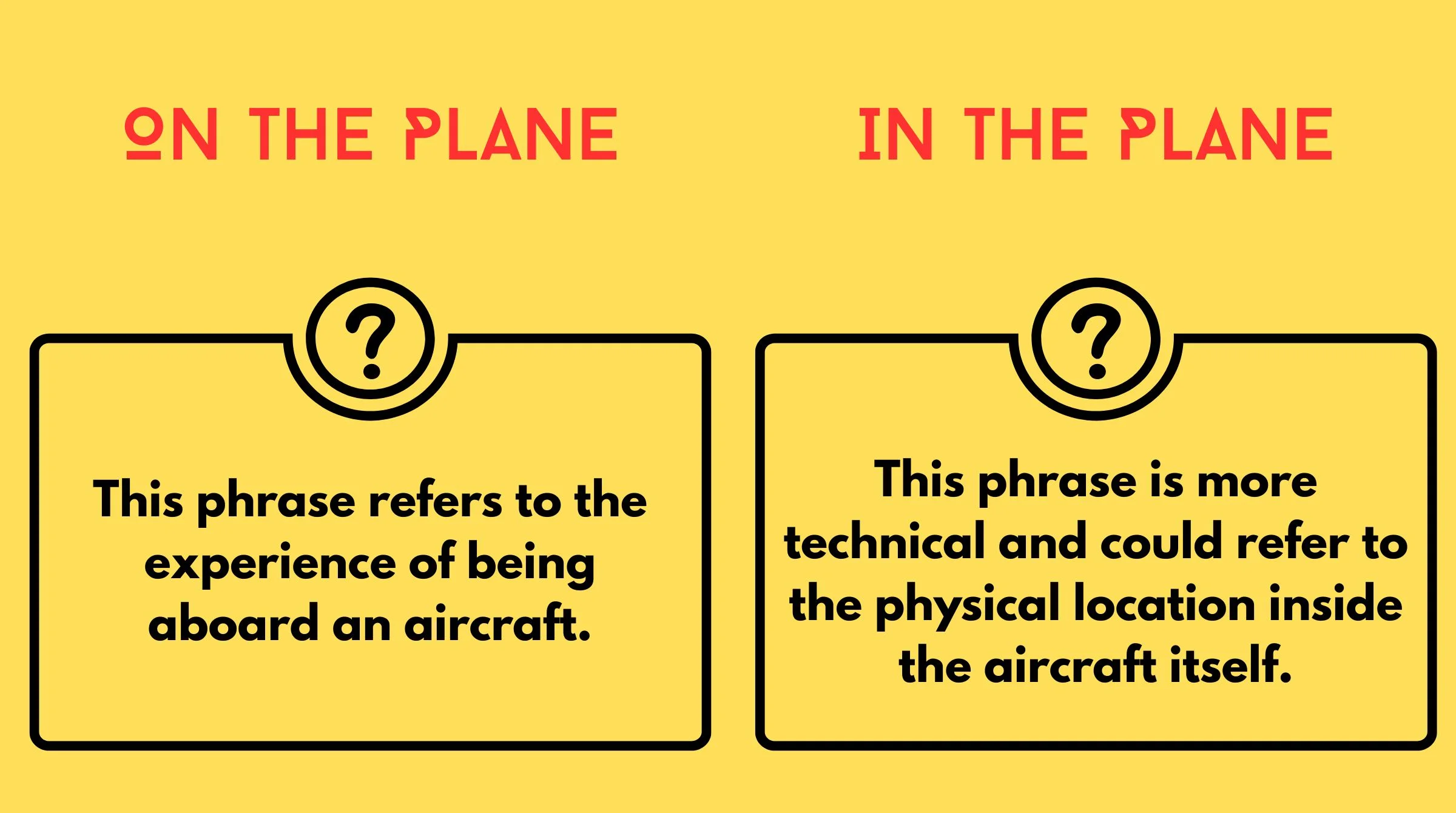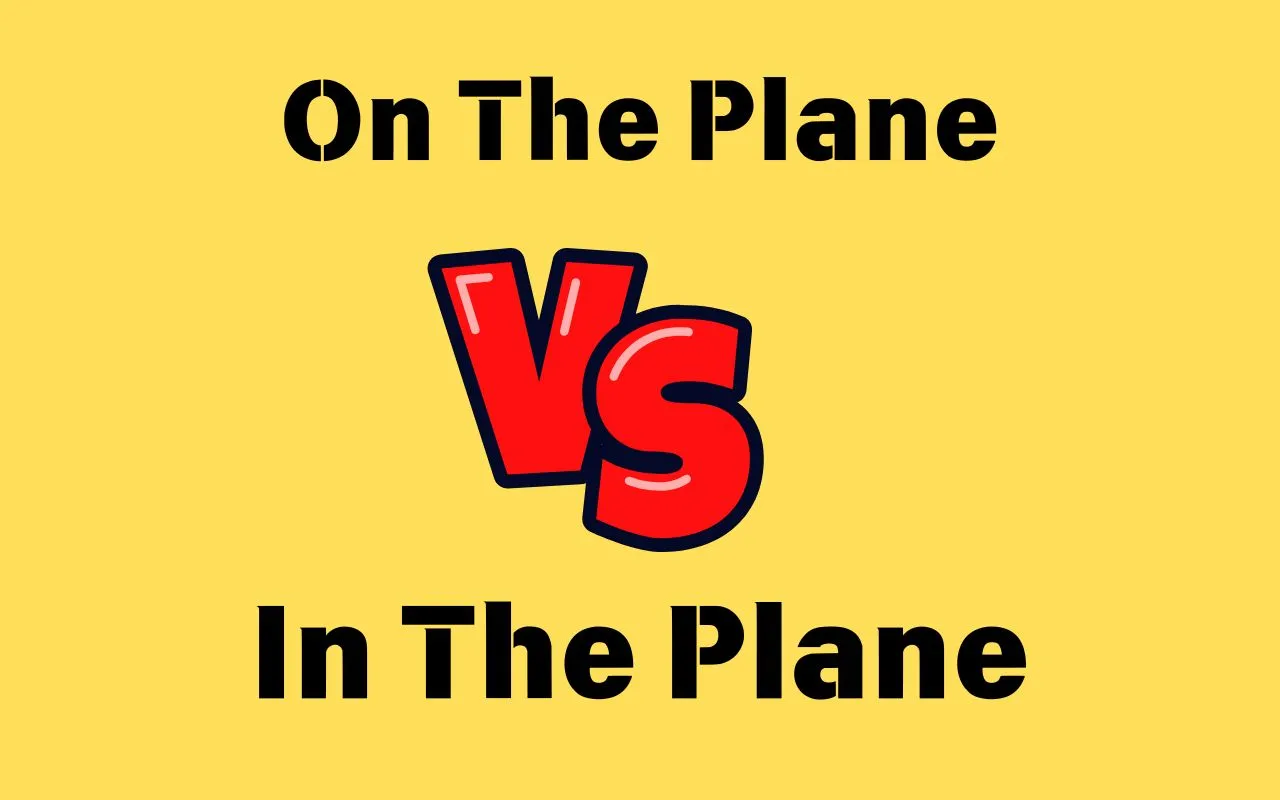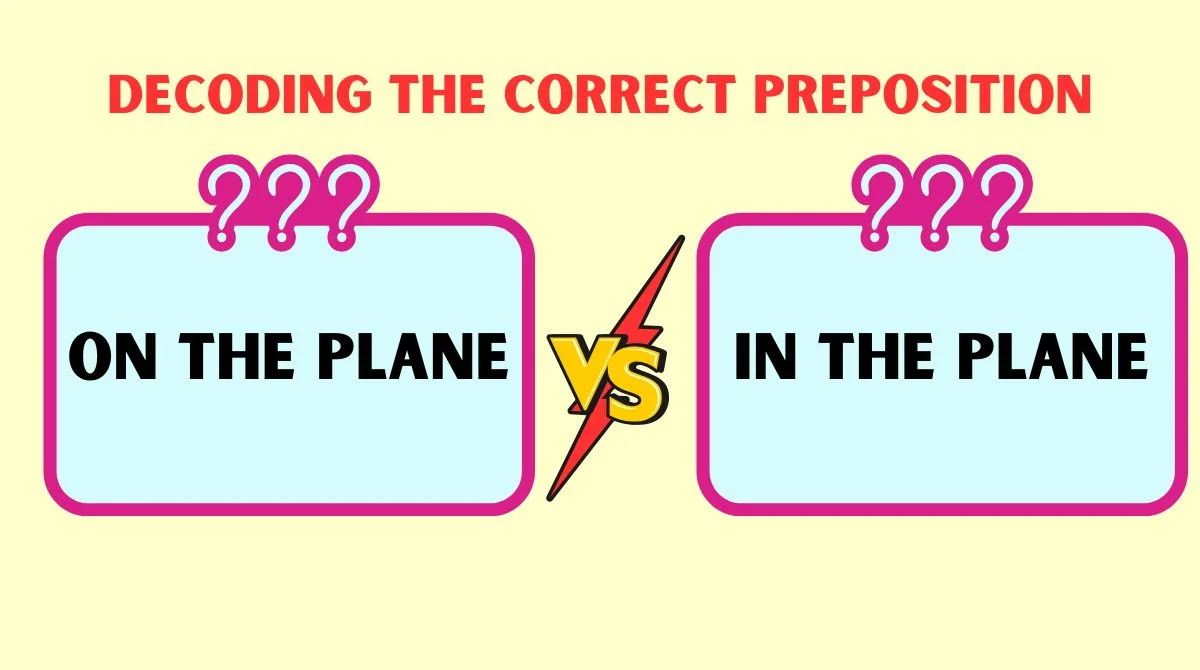Last updated on September 12th, 2025 at 04:49 pm
Prepositions can be tricky, especially when it comes to words we use every day like on and in.
If you’ve ever wondered whether you should say on the plane or in the plane, you’re not alone. The English language is filled with subtle distinctions that affect both how we speak and how we understand one another.
In this article, we’ll explore the nuances of these prepositions and help you master their correct usage when it comes to air travel.

Understanding “On The Plane” vs. “In The Plane”
At first glance, on and in seem interchangeable, but the two prepositions convey different meanings depending on context. When we’re talking about air travel, the distinction becomes clearer.
On the Plane
- This phrase refers to the experience of being aboard an aircraft.
- It emphasizes that you’re inside the space, but also that you’re part of a group or in a larger context, such as a flight.Example: “We’re on the plane, ready for takeoff.”
In the Plane
- This phrase is more technical and could refer to the physical location inside the aircraft itself.
- It emphasizes being within the structure of the plane, focusing more on the physical boundaries of the aircraft.Example: “The pilot is in the plane, preparing for takeoff.”
While both phrases can technically work, on the plane is the more natural and common choice when discussing air travel in everyday conversation.
Ever wondered whether it’s “on the plane” or “in the plane”? This article decodes the subtle difference between these two prepositions in the context of air travel, making it easy to master correct usage.
Exploring The Prepositions: When to Use “On” and “In”
Understanding when to use on and when to use in isn’t just about the plane—it’s about how English speakers view objects and environments. Generally, we use on for surfaces, larger objects, or when something is attached to something else. On the other hand, we use in when something is enclosed or inside a boundary.
- Use on when referring to a vehicle or transport that functions as a platform or a surface.
Example: “I’m on the bus.” “She’s on the train.” - Use in when referring to smaller vehicles or enclosed spaces.
Example: “I’m in the car.” “He’s in the taxi.”
For air travel, on the plane follows the same logic: while you are physically inside the plane, you’re considered on the plane because it’s viewed as a platform for transportation.
The General Rule of Thumb for Transportation
When it comes to transportation, there’s a straightforward rule of thumb that can help you choose the correct preposition:
- Larger or public vehicles (planes, trains, buses, ships): Use on.
- Smaller, enclosed vehicles (cars, taxis, submarines): Use in.
So, for air travel, since a plane is a large, public mode of transport, you’d say, “on the plane” rather than “in the plane,” which could be perceived as overly technical.
Special Cases and Exceptions
English is full of exceptions, and air travel vocabulary is no different. For example, there are situations where “in the plane” might be used:
- Technical or precise contexts: When discussing the physical location inside the plane (e.g., the cockpit, or cabin).
Example: “The engineer is in the plane fixing the radar.” - Metaphorical or figurative speech: If someone is metaphorically “inside” the journey or the experience, they might refer to in the plane.
Example: “I was in the plane when the announcement was made.”
While these cases are less common, they still occur depending on the context.
Navigating the Subtleties of English Prepositions
English prepositions often don’t follow strict logic, which is why native speakers don’t always have trouble with these subtleties. To understand prepositions better, it’s important to grasp the underlying concept of physical versus figurative meanings. Here’s a breakdown:
- In: More common for enclosed spaces. You’re surrounded by something, such as “in the room” or “in the car.”
- On: More common for surfaces or vehicles, as mentioned earlier. You’re positioned on something that has a surface you’re attached to, like “on the floor” or “on the boat.”
When choosing between on and in for planes, it’s about whether you’re thinking of the plane as a space or a mode of transport.
“On The Plane”: The Idiomatic Choice
In most cases, on the plane is the idiomatic and natural way to talk about being aboard an aircraft. It’s an expression that has become deeply embedded in everyday language.
- Idiom Usage:
“On the plane” has been adopted widely in both informal and formal language. We use it in the context of flight schedules, experiences, or interactions aboard the aircraft. For example, “I was on the plane when the turbulence started.” It’s rare for anyone to say “in the plane” unless referring to the physical space. - Why “On” is Preferred:
The term on the plane mirrors how we talk about other large transportation methods. People generally say on the bus, on the train, and on the ship, so it’s a linguistic pattern.
Historical Usage and Current Trends
Historically, both on and in were used to describe being aboard an aircraft, though on has become the dominant choice in modern times. Over the years, as air travel became more routine and mainstream, the phrase on the plane began to dominate in everyday language. There was a shift toward viewing the plane as a mode of transport that one was on, just like a bus or a train, rather than something one was in.
- Past Trends: Early aviation terms often used in the plane, especially in more technical discussions about flight operations. However, with the rise of commercial air travel, on the plane became more commonplace.
- Current Trends: Today, on the plane is the go-to phrase, used by pilots, flight attendants, passengers, and in nearly all airline communications.
Grammatical Nuances of Air Travel Language
The language of air travel also has its quirks. While you are “on the plane” for most purposes, other related terms use in or on based on context.
Related Phrases:
- In the cockpit: Refers to the pilot’s area inside the plane.
- On the runway: Describes the plane before it takes off.
- In the air: Refers to the flight being airborne.
Notice how the use of prepositions shifts based on the part of the journey and what aspect of the plane you’re referring to.
Additional Insights: “By Plane” and “Travel By Plane”
Another related phrase is “by plane,” which means to travel using a plane as your mode of transport. This phrase is common when discussing travel routes or choices of transportation.
- Example: “I prefer to travel by plane because it’s faster.”
Key difference: While on the plane refers to being inside the aircraft during your journey, by plane focuses on the mode of transport.
Cultural and Contextual Influences on Language

Language usage often varies across cultures, and English is no exception. Different English-speaking countries may have slightly different preferences for using on and in. However, across the board, on the plane is the most widely accepted and used term.
In more technical settings, such as aviation or engineering, professionals might use in the plane to describe specific operations or locations inside the aircraft.
Conclusion
Understanding when to use on the plane vs. in the plane is a subtle but important aspect of English grammar.
By following general rules about transportation prepositions and recognizing when exceptions apply, you can confidently use these phrases correctly.
Whether you’re preparing for your next flight or explaining air travel to others, remember: it’s typically on the plane, and that’s the most idiomatic choice.
